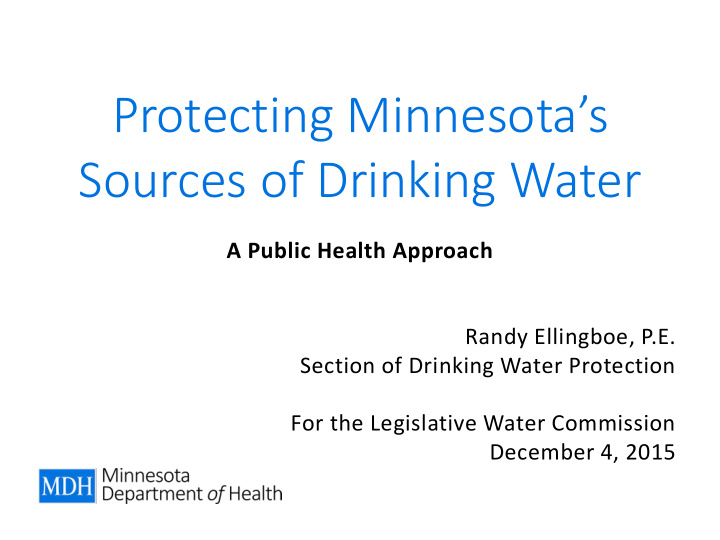



Protecting Minnesota’s Sources of Drinking Water A Public Health Approach Randy Ellingboe, P.E. Section of Drinking Water Protection For the Legislative Water Commission December 4, 2015
Outline Source Water Protection Strategies Land Uses Drive Water Quality People Decide How Land is Used Connecting with People to Protect Source Water Challenges and Opportunities
Drinking Water Sources in Minnesota Public Private Surface Groundwater Water 1.1 Million 1.4 Million Public Groundwater 3 Million 75% from groundwater 25% from surface water FY 2015
Public Water Supply Systems Serve 4.4 million people • 24 surface water sources • ~11,000 Public Wells • ~960 systems that provide • water to people where they live ~6,000 systems that provide • water to people where they work or play Public Water Supplies in MN
Source Water Protection Preventing contamination in a well’s recharge area Required in statute for groundwater systems (MS s 103I.101) Surface intake protection are voluntary – 3 plans More effective and cost- efficient than clean-up, treatment, or drilling a new Public Water Supplies in MN well
Public Health Targets and Prevents Source Water Protection Strategies Scientists define a protection area to target Planners determine actions to prevent contamination in the area Schedule: every 10 years, or with new well
Local Ownership of Protection Plans Source Water Protection Strategies Public water supplier works with local government, businesses, and land owners to manage threats Tools: relationships, ordinances, easements, grants, etc.
4.4 Million People to Protect Source Water Protection Strategies 963 total community water systems Prioritize large populations, high risk systems first Plans so far protect 87% of people on public water supplies
Land Use Drives Water Quality http://www.mortenson.com/sports/projects/us-bank-stadium Urban
Urban Land Use Land Use Drives Water Quality Residential http://realestatetwincities.net.idxco.com/i /2517/scott_county_mn_lake_homes
Goal is Prevention, but… Land Use Drives Water Quality Perham: Shallow sand and gravel aquifers Nitrate approaches drinking water standard City builds momentum through outreach and education Converted 285 acres in wellhead area from row crop to other, low-impact uses Nitrate reduced to meet drinking water standards
Land Use in Minnesota People Decide How Land is Used 56 M acres total 70% of 26 M acres in agricultural MN Land production Privately 16 M acres of forest Owned 13 M acres of lakes, rivers, and wetlands 70% of land is privately owned
High Risk Drinking Water Acreage People Decide How Land is Used Acres in MN = 56 M Well areas = 1.22 M Vulnerable acres = 360 K Growing as more protection plans are completed Do-able
Multiple Benefits People Decide How Land is Used Worthington Wells Wildlife Management Area
Individual Level Connecting with People to Protect Source Water http://alleynews.org/2013/02/hobt-mayday-parade-pageant- february-ideas-support-request/
Community Level Connecting with People to Protect Source Water Annual residential turf management clinics protect vulnerable water supplies
Social and Economic System Level Connecting with People to Protect Source Water
Challenges Our actions on the land threaten the safety of our drinking water Source water protection largely relies on voluntary actions by citizens, businesses, and communities Markets and economic systems can make easement opportunities less attractive
Opportunities Build capacity in local governments to engage citizens and decision- makers Facilitate land use changes that have multiple benefits Develop competitive financial support for land uses that protect drinking water
Questions?
Recommend
More recommend